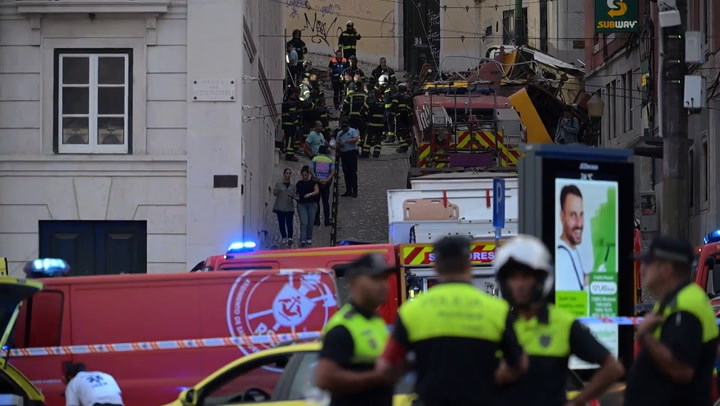Overview of the Lisbon Funicular Crash
At least 17 people lost their lives following a catastrophic derailment of the Gloria funicular railway in Lisbon, a historic cable car attraction. The incident injured over twenty tourists representing ten different countries, highlighting both the international nature of the tragedy and the vulnerability of popular urban transit systems. Emergency services responded swiftly around 6 pm on the day of the accident to extract victims from the wreckage.
The Incident and Immediate Response
The funicular’s cable reportedly came loose, causing one of the parallel cars to derail and crash into a building. Each car normally carries up to 40 passengers on the steep, curved hill where public traffic is otherwise restricted. Following this disaster, municipal authorities suspended operations of Lisbon’s other cable cars for thorough inspections. The operator, Carris, assured that comprehensive maintenance protocols, including daily, weekly, and monthly checks, had been adhered to prior to the accident.
Victims and Ongoing Investigations
The fatalities remain unidentified officially, but local authorities confirmed the involvement of approximately 38 individuals during the crash. Portugal’s President extended condolences to families affected while emphasizing the ongoing work to determine the cause of the derailment. In addition to civil authorities, an independent investigation was initiated by Carris to establish responsibility and prevent future tragedies.
Historical Context of the Gloria Funicular
Opened in 1885, the Gloria funicular holds not only a practical role in Lisbon’s transport network but also a cultural and historic significance as a national monument. It is a cherished route used daily by locals and tourists alike to navigate the city’s hills. Lisbon itself is a city whose landscape and infrastructure have evolved through calamities and renovations, from the great 1755 earthquake to modern developments that supported global events, such as Expo ’98, which included infrastructure upgrades in public transit and the waterfront area.
Legacy and Role in Tourism
The funicular has long been a symbol of Lisbon’s charm while representing the challenges of integrating historic transport methods into modern urban life. Situated in a city that welcomed approximately 8.5 million visitors last year, the mechanism blends tradition with daily utility, making safety and preservation paramount.
Impact on Lisbon’s Tourism and Public Safety
Lisbon’s vibrant tourism sector, a key contributor to the city’s economy, has been shaken by this accident. The event prompted an immediate pause on similar transportation systems to reassure visitors and residents that safety remains a priority. National football teams and political leaders expressed solidarity, reflecting the profound communal impact of the incident. Health officials actively monitored victims’ recovery across hospitals, highlighting the inclusion of vulnerable individuals such as children and expectant mothers among the injured.
Official Responses and Safety Measures
- Emergency services praised for rapid crisis intervention limiting further casualties.
- Closure of all related cable cars and elevators by municipal operator pending safety reviews.
- Launch of a dedicated hotline for affected families and friends to offer support and updates.
- Condolences from international figures underscoring the global attention on the tragedy.
Forecast for the Future of Lisbon’s Transit and Tourism
The derailment raises broader questions about the integration of heritage transportation in bustling urban centers and their resilience amid growing tourism volumes. While Lisbon remains a sought-after European destination, the accident may serve as a catalyst for stricter safety standards and modernized infrastructure across funicular and cable car operations not only in Lisbon but potentially in other historic coastal cities.
In the context of international tourism, the event highlights the delicate balance between preserving cultural landmarks and ensuring visitor safety. As destinations worldwide continue to attract tourists eager to experience authentic transport and local charm, proactive measures must safeguard against incidents that could disrupt travel and economic stability.
Summary Table: Key Facts of the Lisbon Funicular Crash
| Aspect | Details |
|---|---|
| 地点 | Lisbon, Portugal |
| Incident | Funicular cable car derailment |
| Date & Time | Wednesday, approx. 6pm |
| Fatalities | 17 confirmed dead |
| Injuries | At least 21 tourists injured |
| Nationalities Involved | Tourists from 10 different countries |
| Operator | Carris (municipal public transport company) |
| Vehicle Capacity | Approx. 40 passengers per car |
| Historical Start Year | 1885 |
| Current Status | Other cable cars temporarily suspended |
展望未来
This unfortunate incident serves as a somber reminder of the continuous vigilance required in managing the intersection of tourism, historic transport systems, and urban safety. Lisbon, famed for its maritime charm and vibrant cityscape, continues to attract lovers of sailing, boating, and beach-side destinations. For enthusiasts of yachting and boating activities visiting Lisbon, exploring water adventures alongside city history offers a compelling combination.
For those planning yacht charters or boating excursions in and around Lisbon’s waterways, GetBoat.com provides an international marketplace to rent sailing yachts and boats suited to various tastes and budgets. In a city rich with history yet looking to the future, such services connect travelers with the sea, where safety, leisure, and adventure meet harmoniously.

 Fatal Cable Car Derailment in Lisbon Injures Tourists from Multiple Nations">
Fatal Cable Car Derailment in Lisbon Injures Tourists from Multiple Nations">
